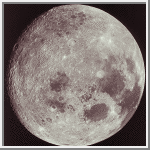
- Captain Cook
Copyright © 1995-2011 by Rosanna L. Hamilton. All rights reserved.
|
Table of Contents |
|
Moon Introduction
|
|
Lunar Science |
|
Additional Resources |
|
Apollo Mission Publications |
|
Apollo Lunar Surface Journal |
|
Apollo 11,
Apollo 12,
Apollo 13,
Apollo 14,
Apollo 15,
Apollo 16,
Apollo 17
|
On July 20, 1969, Neil Armstrong became the first man to step onto the surface of the Moon. He was followed by Edwin Aldrin, both of the Apollo 11 mission. They and other moon walkers experienced the effects of no atmosphere. Radio communications were used because sound waves can only be heard by travelling through the medium of air. The lunar sky is always black because diffraction of light requires an atmosphere. The astronauts also experienced gravitational differences. The moon's gravity is one-sixth that of the Earth's; a man who weighs 180 lbf (pound-force) on Earth weighs only 30 lbf on the Moon. (The equivalent metric weight (or force) is the Newton, where 4.45 Newtons equal one pound-force.)
The Moon is 384,403 kilometers (238,857 miles) distant from the Earth. Its diameter is 3,476 kilometers (2,160 miles). Both the rotation of the Moon and its revolution around Earth takes 27 days, 7 hours, and 43 minutes. This synchronous rotation is caused by an unsymmetrical distribution of mass in the Moon, which has allowed Earth's gravity to keep one lunar hemisphere permanently turned toward Earth. Optical librations have been observed telescopically since the mid-17th century. Very small but real librations (maximum about 0°.04) are caused by the effect of the Sun's gravity and the eccentricity of Earth's orbit, perturbing the Moon's orbit and allowing cyclical preponderances of torque in both east-west and north-south directions.
Four nuclear powered seismic stations were installed during the Apollo project to collect seismic data about the interior of the Moon. There is only residual tectonic activity due to cooling and tidal forcing, but other moonquakes have been caused by meteor impacts and artificial means, such as deliberately crashing the Lunar Module into the moon. The results have shown the Moon to have a crust 60 kilometers (37 miles) thick at the center of the near side. If this crust is uniform over the Moon, it would constitute about 10% of the Moon's volume as compared to the less than 1% on Earth. The seismic determinations of a crust and mantle on the Moon indicate a layered planet with differentiation by igneous processes. There is no evidence for an iron-rich core unless it were a small one. Seismic information has influenced theories about the formation and evolution of the Moon.
The Moon was heavily bombarded early in its history, which caused many of the original rocks of the ancient crust to be thoroughly mixed, melted, buried, or obliterated. Meteoritic impacts brought a variety of "exotic" rocks to the Moon so that samples obtained from only 9 locations produced many different rock types for study. The impacts also exposed Moon rocks of great depth and distributed their fragments laterally away from their places of origin, making them more accessible. The underlying crust was also thinned and cracked, allowing molten basalt from the interior to reach the surface. Because the Moon has neither an atmosphere nor any water, the components in the soils do not weather chemically as they would on Earth. Rocks more than 4 billion years old still exist there, yielding information about the early history of the solar system that is unavailable on Earth. Geological activity on the Moon consists of occasional large impacts and the continued formation of the regolith. It is thus considered geologically dead. With such an active early history of bombardment and a relatively abrupt end of heavy impact activity, the Moon is considered fossilized in time.
The Apollo and Luna missions returned 382 kilograms (840 pounds) of rock and soil from which three major surface materials have been studied: the regolith, the maria, and the terrae. Micrometeorite bombardment has thoroughly pulverized the surface rocks into a fine-grained debris called the regolith. The regolith, or lunar soil, is unconsolidated mineral grains, rock fragments, and combinations of these which have been welded by impact-generated glass. It is found over the entire Moon, with the exception of steep crater and valley walls. It is 2 to 8 meters (7 to 26 feet) thick on the maria and may exceed 15 meters (49 feet) on the terrae, depending on how long the bedrock underneath it has been exposed to meteoritic bombardment.
The dark, relatively lightly cratered maria cover about 16% of the lunar surface and is concentrated on the nearside of the Moon, mostly within impact basins. This concentration may be explained by the fact that the Moon's center of mass is offset from its geometric center by about 2 kilometers (1.2 miles) in the direction of Earth, probably because the crust is thicker on the farside. It is possible, therefore, that basalt magmas rising from the interior reached the surface easily on the nearside, but encountered difficulty on the farside. Mare rocks are basalt and most date from 3.8 to 3.1 billion years. Some fragments in highland breccias date to 4.3 billion years and high resolution photographs suggest some mare flows actually embay young craters and may thus be as young as 1 billion years. The maria average only a few hundred meters in thickness but are so massive they frequently deformed the crust underneath them which created fault-like depressions and raised ridges.
The relatively bright, heavily cratered highlands are called terrae. The craters and basins in the highlands are formed by meteorite impact and are thus older than the maria, having accumulated more craters. The dominant rock type in this region contain high contents of plagioclase feldspar (a mineral rich in calcium and aluminum) and are a mixture of crustal fragments brecciated by meteorite impacts. Most terrae breccias are composed of still older breccia fragments. Other terrae samples are fine-grained crystalline rocks formed by shock melting due to the high pressures of an impact event. Nearly all of the highland breccias and impact melts formed about 4.0 to 3.8 billion years ago. The intense bombardment began 4.6 billion years ago, which is the estimated time of the Moon's origin.
| Moon Statistics | |
|---|---|
| Mass (kg) | 7.349e+22 |
| Mass (Earth = 1) | 1.2298e-02 |
| Equatorial radius (km) | 1,737.4 |
| Equatorial radius (Earth = 1) | 2.7241e-01 |
| Mean density (gm/cm^3) | 3.34 |
| Mean distance from Earth (km) | 384,400 |
| Rotational period (days) | 27.32166 |
| Orbital period (days) | 27.32166 |
| Average length of lunar day (days) | 29.53059 |
| Mean orbital velocity (km/sec) | 1.03 |
| Orbital eccentricity | 0.0549 |
| Tilt of axis (degrees) | 1.5424 |
| Orbital inclination (degrees) | 5.1454 |
| Equatorial surface gravity (m/sec^2) | 1.62 |
| Equatorial escape velocity (km/sec) | 2.38 |
| Visual geometric albedo | 0.12 |
| Magnitude (Vo) | -12.74 |
| Mean surface temperature (day) | 107°C |
| Mean surface temperature (night) | -153°C |
| Maximum surface temperature | 123°C |
| Minimum surface temperature | -233°C |
- Full Length Movie: Apollo 11 - For All Mankind
- Full Length Movie: Apollo 12 - Pinpoint For Science
- Full Length Movie: Apollo 13 - Houston, We've Got a Problem
- Full Length Movie: Apollo 14 - Mission to Fra Mauro
- Full Length Movie: Apollo 15 - In the Mountains of the Moon
- Full Length Movie: Apollo 16 - Nothing so Hidden
- Full Length Movie: Apollo 17 - On the Shoulders of Giants
- Rotating Moon Animation.
- Moon Topography Animation.
- Lunar Phase Animation.
- Galileo Moon Encounter.
- A dramatic view of the moon with Venus in the distance.
- Clementine images showing the Apollo 16 lunar landing site.
- Astronauts walking near lunar lander and US flag.
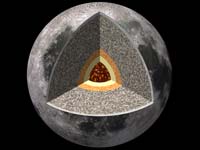 Interior of the Moon
Interior of the Moon
This artist's conception shows the interior of the moon based off of new
research by NASA. The moon contains 5 major divisions in its interior.
It possesses a solid, iron-rich inner core with a radius of nearly 150 miles
and a fluid, primarily liquid-iron outer core with a radius of roughly 205
miles. It has a partially molten boundary layer around the core estimated to
have a radius of nearly 300 miles followed by the mantle and then the crust.
The moon's crust varies from tens of kilometers in depth (under mare basins) to
more than 100 kilometers in some highland regions, with an average thickness of about 70 kilometers.
[ more information ]
(Copyright 2011 Calvin J. Hamilton)
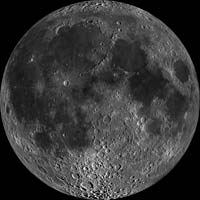 Lunar Nearside Spectacular!
Lunar Nearside Spectacular!
For two weeks in mid-December 2010, the LRO spacecraft remained nadir looking (straight down) so that the LROC Wide Angle Camera (WAC) could acquire ~1300 images, allowing the LROC team to construct this spectacular mosaic. As the Moon rotated under LRO's orbit, the ground track progressed from east to west (right to left in this mosaic), and the incidence angle at the equator increased from 69° to 82° (at noontime the incidence angle is 0°).
(Courtesy NASA/GSFC/Arizona State University)
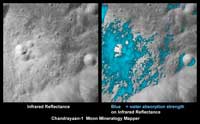 Water Around a Fresh Crater
Water Around a Fresh Crater
These images show a very young lunar crater on the side of the moon that
faces away from Earth, as viewed by NASA's Moon Mineralogy Mapper on the
Indian Space Research Organization's Chandrayaan-1 spacecraft. On the left
is an image showing brightness at shorter infrared wavelengths. On the
right, the distribution of water-rich minerals (light blue) is shown around
a small crater. Both water- and hydroxyl-rich materials were found to be
associated with material ejected from the crater.
(Courtesy ISRO/NASA/JPL-Caltech/USGS/Brown Univ.)
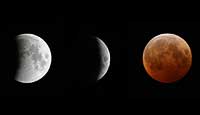 2004 Lunar Eclipse
2004 Lunar Eclipse
On Wednesday October 27, 2004 the moon passed into Earth's shadow for more
than
three hours. It began at 9:14 p.m EST with totality beginning at 10:23 p.m.
and ending at 11:45 p.m. The eclipse passed out of Earth shadow at 00:54 a.m
(Oct. 28).
(Copyright Calvin J. Hamilton)
 Apollo 17 - Whole Moon View
Apollo 17 - Whole Moon View
This full disc of the Moon was photographed by the Apollo 17 crew during
their trans-Earth coast homeward following a successful lunar landing
mission in December 1972. Mare seen on this photo include Serentatis,
Tranquillitatis, Nectaris, Foecunditatis and Crisium.
(Courtesy NASA)
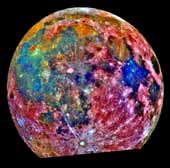 Moon - False Color Mosaic
Moon - False Color Mosaic
This false-color photograph of the Moon was taken by the Galileo
spacecraft on December 8, 1992. The false-color processing used to
create this lunar image is helpful for interpreting the surface soil
composition. Areas appearing red generally correspond to the lunar
highlands, while blue to orange shades indicate the ancient volcanic lava
flow of a mare, or lunar sea. Bluer mare areas contain more titanium than
do the orange regions. Mare Tranquillitatis, seen as a deep blue patch on
the right, is richer in titanium than Mare Serenitatis, a slightly smaller
circular area immediately adjacent to the upper left of Mare
Tranquillitatis. Blue and orange areas covering much of the left side of
the Moon in this view represent many separate lava flows in Oceanus
Procellarum. The small purple areas found near the center are pyroclastic
deposits formed by explosive volcanic eruptions. The fresh crater Tycho,
with a diameter of 85 kilometers (53 miles), is prominent at the bottom of
the photograph.
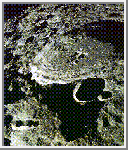 Far Side of the Moon
Far Side of the Moon
This image was taken by Apollo 11 astronauts in 1969. It shows a portion
of the Moon's heavily cratered far side. The large crater is
approximately 80 km ( 50 miles ) in diameter.
The rugged terrain seen here is typical of the farside of the Moon.
(Courtesy NASA)
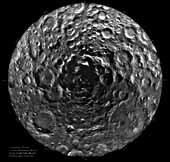 Lunar South Pole
Lunar South Pole
This mosaic is composed of 1,500 Clementine images
of the south polar region of the Moon.
The top half of the mosaic
faces Earth. Clementine has revealed what appears to be a major
depression near the lunar south pole (center), evident from the presence
of extensive shadows around the pole. This depression probably is an
ancient basin formed by the impact of an asteroid or comet. A
significant portion of the dark area near the pole may be in permanent
shadow, and sufficiently cold to trap water of cometary origin in the
form of ice.
The impact basin Schrodinger (near the 4 o'clock position) is a
two-ring basin, about
320 kilometers (200 miles)
in diameter which is
recognized to be the second youngest impact basin on the Moon.
The center of Schrodinger is flooded by lavas.
A volcanic vent seen in the floor of Schrodinger is one of
the largest single explosive volcanoes on the Moon.
(Courtesy Naval Research Laboratory.)
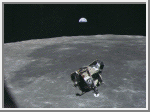 Apollo 11
Apollo 11
The Apollo 11 Lunar Module (LM)
ascent stage, with Astronauts Neil A. Armstrong
and Edwin E. Aldrin Jr. aboard, is photographed from the Command and
Service Module (CSM) during rendezvous in lunar orbit. The LM
was making its docking approach to the CSM. Astronaut Michael Collins
remained with the CSM in lunar orbit while the other two crewmen explored
the lunar surface. The large, dark-colored area in the background is
Smyth's Sea, centered at 85 degrees east longitude and 2 degrees south
latitude on the lunar surface (nearside). This view looks west. The Earth
rises above the lunar horizon. (Courtesy NASA)
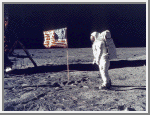 Apollo 11 - Flag
Apollo 11 - Flag
Astronaut Edwin E. Aldrin Jr., lunar module pilot, poses for a photograph
beside the deployed United States flag during Apollo 11 extravehicular
activity on the lunar surface. The Lunar Module
Eagle is on the left. The
footprints of the astronauts are clearly visible in the soil of the Moon.
This picture was taken by Astronaut Neil A. Armstrong, commander, with a
70mm lunar surface camera. (Courtesy NASA)
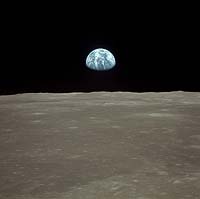 Apollo 11 - Earth Rises Over Lunar Horizon
Apollo 11 - Earth Rises Over Lunar Horizon
This view of the Earth rising over the Moon's horizon was taken from the
Apollo 11 spacecraft. The lunar terrain pictured is in the area of
Smyth's Sea on the nearside. (Courtesy NASA)
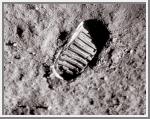 Apollo 11 - Footprint on the Moon
Apollo 11 - Footprint on the Moon
A close-up view of an astronaut's footprint in the lunar soil,
photographed with a 70mm lunar surface camera during the Apollo 11
extravehicular activity (EVA) on the Moon.
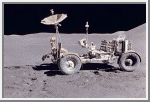 Apollo 15 - Lunar Roving Vehicle
Apollo 15 - Lunar Roving Vehicle
This is a view of the Lunar Roving Vehicle photographed alone against
the desolate lunar background during an Apollo 15 lunar surface
extravehicular activity (EVA) at the Hadley-Apennine landing site. This
view is looking north. The west edge of Mount Hadley is at the upper right
edge of the picture. Mount Hadley rises approximately 4,500 meters
(14,800 feet) above the plain. The most distant lunar feature visible is
approximately 25 kilometers (16 miles) away.
(Courtesy NASA)
 Apollo 17 - Taurus-Littrow Landing Site
Apollo 17 - Taurus-Littrow Landing Site
This is the landing site of the last Apollo mission (Apollo 17). It was
in the valley among the Taurus-Littrow hills on the southeastern rim of
Mare Serenitatis. Astronauts Eugene Cernan and Harrison H. Schmitt
explored the valley with the aid of an electrically powered car. This
image shows Schmitt inspecting a huge boulder that has rolled down the
side of an adjacent hill.
(Courtesy NASA)
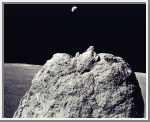 Apollo 17 - Large Lunar Boulder
Apollo 17 - Large Lunar Boulder
Earth in the far distant background is seen above a large lunar boulder
on the Moon. This photo was taken with a handheld Hasselblad camera by the
last two Moon walkers in the Apollo Program.
(Courtesy NASA)
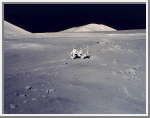 Apollo 17 - Lunar Scape
Apollo 17 - Lunar Scape
This image is an excellent view of the desolate lunar space at Station 4
showing scientist-astronaut Harrison H. Schmitt, lunar module pilot,
working at the Lunar Roving Vehicle during the second Apollo 17 extravehicular
activity at the Taurus-Littrow landing site. This is the area where Schmitt
first spotted the orange soil which is visible on either side of the Lunar
Roving Vehicle in this picture. Shorty Crater is to the right, and the peak
in the center background is Family Mountain. A portion of South Massif is
on the horizon at the left edge.
(Courtesy NASA)
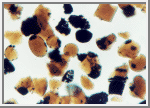 Apollo 17 - Orange Soil
Apollo 17 - Orange Soil
These orange glass spheres and fragments are the finest particles ever brought
back from the Moon. The
particles
range in size from 20 to 45 microns. The
orange soil was brought back from the Taurus-Littrow landing site by the
apollo 17 crewmen. Scientist-Astronaut Harrison J. Schmitt discovered the
orange soil at Shorty Crater. The orange particles, which are intermixed
with black and black-speckled grains, are about the same size as the
particles that compose silt on Earth. Chemical analysis of the orange soil
material has show the sample to be similar to some of the samples brought
back from the Apollo 11 (Sea of Tranquility) site several hundred miles to
the southwest. Like those samples, it is rich in titanium (8%) and iron
oxide (22%). But unlike the Apollo 11 samples, the orange soil is
unexplainably rich in zinc. The orange soil is probably of volcanic origin
and not the product of meteorite impact.
(Courtesy NASA)
 Limb of Copernicus Impact Crater
Limb of Copernicus Impact Crater
This image of Copernicus was acquired on the Lunar Orbiter 5 Mission.
Copernicus is 93 kilometers wide and is located within the
Mare Imbrium Basin, northern nearside of the Moon (10° N, 20°
degrees W.). Image shows crater floor, floor mounds, rim, and rayed
ejecta. Rays from the ejecta are superposed on all other surrounding
terrains which places the crater in its namesake age group: the Copernican
system, established as the youngest assemblage of rocks on the Moon
(Shoemaker and Hackman, 1962, The Moon: London, Academic Press, p.289-300).
(Courtesy USGS/NASA)
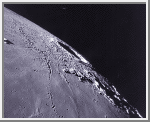 Apollo 17 - Oblique view of Copernicus
Apollo 17 - Oblique view of Copernicus
This is an oblique view of the large crater Copernicus on the lunar
nearside, as phtographed from the Apollo 17 spacecraft in lunar orbit.
(Courtesy NASA)

 Earth
Earth